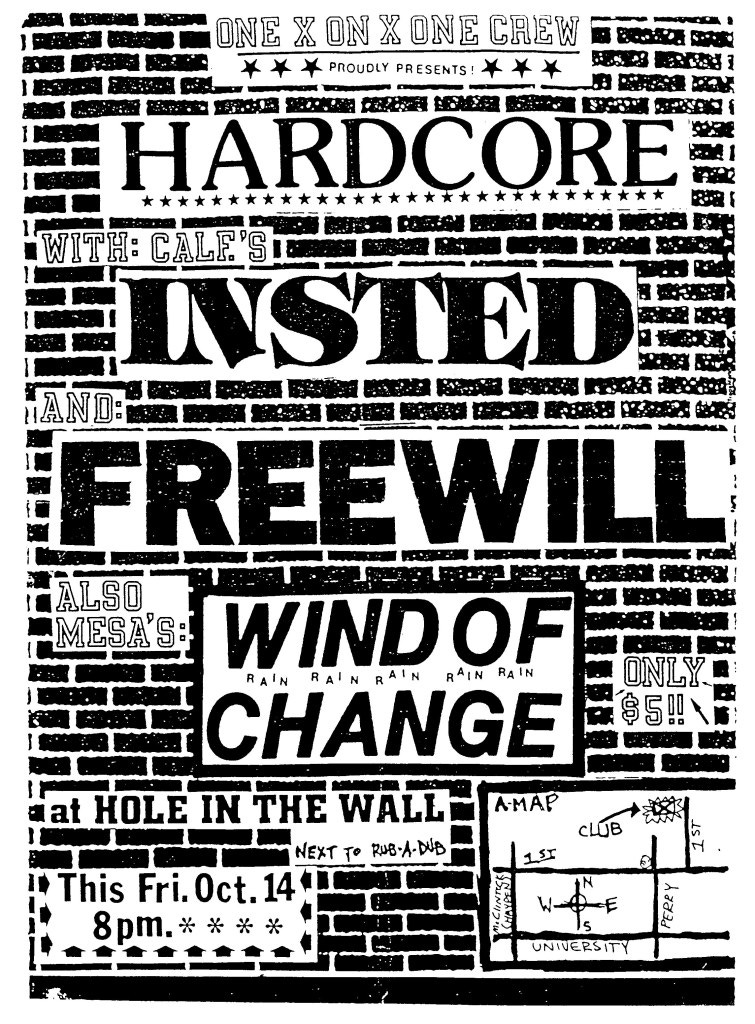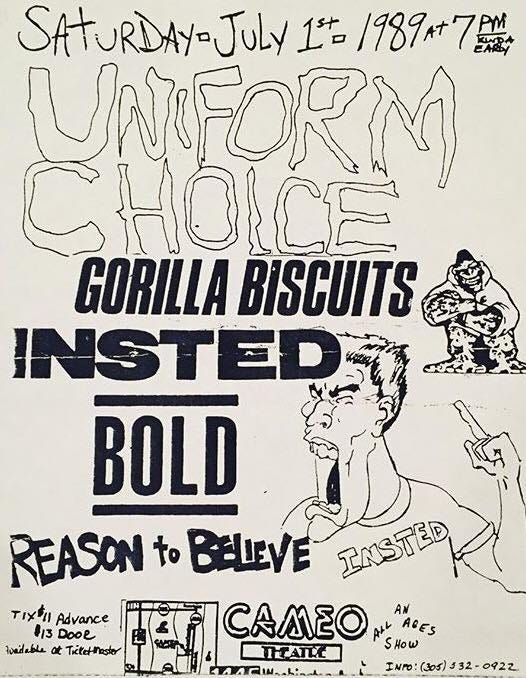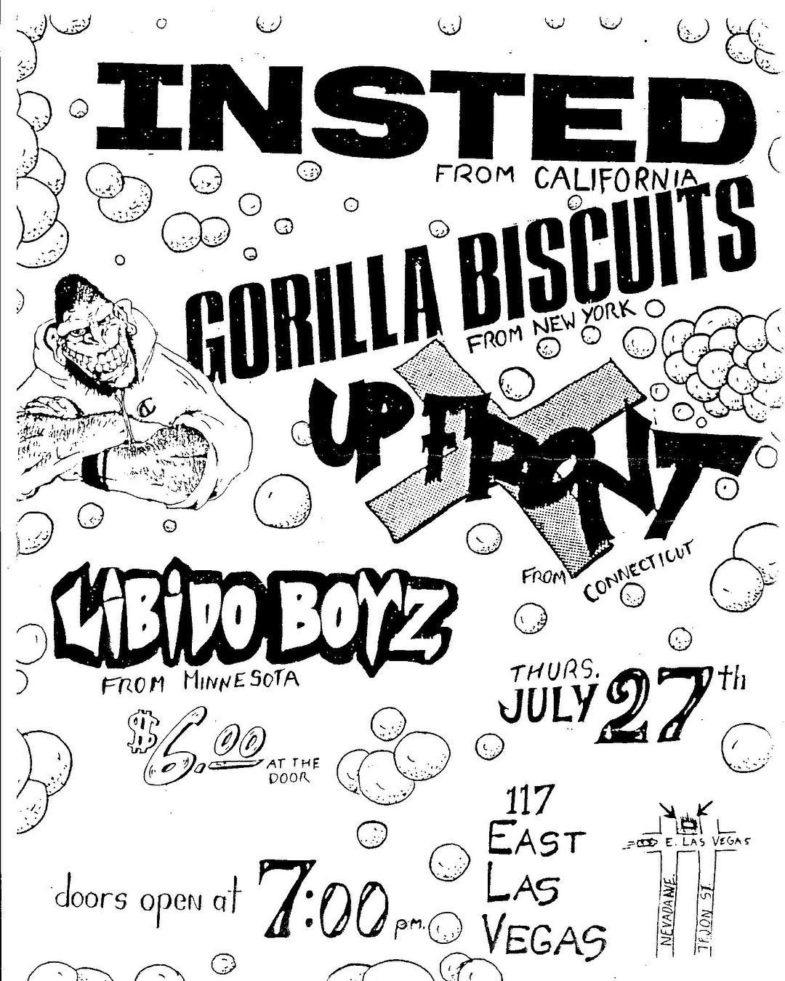FROM THE STRAIGHT EDGE BOOK ARCHIVES: Rich Labbate (Insted)

This interview with Insted bass player Rich Labatte was conducted in the spring of 2015 for my third book, Straight Edge: A Clear-Headed Hardcore Punk History.
Many people cite Stalag 13 as the first Straight Edge band in Southern California. Would you agree with that?
I didn’t consider Stalag 13 a Straight Edge band. Their singer was Straight Edge, but they didn’t have super in-your-face Straight Edge songs. But when Uniform Choice came in, they were what I’d consider a Straight Edge band. There were X’s everywhere and they were promoting that lifestyle and were way more in your face about it than Stalag 13. Also, 7 Seconds had also come through enough times from Reno to influence some bands.
One band people tell me don’t get enough credit for spreading Straight Edge in Southern California is Doggy Style.
Doggy Style was right behind Uniform Choice. They had a couple of members who were Straight Edge and they had some Straight Edge songs. That’s when I noticed Hardcore had a faction within it and it was the start of a Straight Edge scene. Before that, it was just Hardcore and Punk bands mixed in. But when Uniform Choice and Doggy Style started playing out consistently in early ‘84, that was when I noticed there was an affiliation with Straight Edge and it seemed different than playing with the Dead Kennedys or The Varukers.
As far as the scene Insted was a part of in the latter part of the ’80s, was that jump-started by Youth Of Today coming out with 7 Seconds in ‘85?
I remember being at Toxic Shock, a local record store in Pomona where Bill Tuck, the singer in a local band called Pillsbury Hardcore worked. Ray Cappo was on the phone with him and was talking about his band Youth of Today and how they sounded very reminiscent of Antidote and they were coming out to tour with 7 Seconds. I was a huge fan of Antidote, so I was interested. When Youth of Today showed up, they brought a different style of Hardcore to Southern California. They brought the east coast mosh and that was very welcomed.
You brought up Pillsbury Hardcore. How important were they to the local scene? Pillsbury Hardcore was a joke lyrically and would always poke fun at themselves. They weren’t very good and they knew it. But the bass player Eric Wood and the singer Bill Tuck both worked at Toxic Shock and those guys are responsible for turning on a lot of kids to some great records.
What was your first reaction when you heard Youth Of Today?
I was a person who was into Dischord Records and buying the seven-inch EP’s by S.O.A and Minor Threat. But then all of a sudden they start putting this stuff out like Beefeater where I was like, “What the fuck is this?” Then in Boston, DYS and SSD became full-blown cock rock. Agnostic Front was onto their Cause For Alarm record by then, too. Everything was changing. So, to have a band like Youth of Today come out and sound like this perfect blend of Boston and New York Hardcore was great. They were these guys just like me who loved that ‘82 and ‘83 sound and saw it slipping away so they tried to keep it together.
How developed was the Straight Edge scene in the area when Uniform Choice put out their first LP, Screaming For Change?
When Screaming for Change came out, the seeds were already in the ground and bands like Insted, Half Off and Visual Discrimination sprouted up. That was the next wave locally. Hard Stance came shortly after that and No For An Answer popped up quickly after that. It all happened really quick; within six months all this developed. But I would give the credit to both Uniform Choice and Youth of Today as far as hyping up a Straight Edge scene in Southern California.

Could you give me an idea of how important Uniform Choice was prior to the release of the LP?
Uniform Choice live in 1984 was something very special. By the time they hit the road and went across the U.S, that magic didn’t exist anymore. Their early shows were at clubs like Flashdance or the Olympic Auditorium and even backyard parties in Huntington Beach or sometimes at a park. It was so powerful and so moving, you couldn’t help to buy the t-shirt before you left. You were affected by it and you probably thought about it for weeks on end. For me, they were incredible. Youth of Today probably had the same thing going on the east coast but when they brought it to the west coast, we embraced it. Their live show was outstanding and I think a lot of bands formed after witnessing both of those bands out here.
Explain to me what the Los Angeles Hardcore scene was like in the ’80s?
It was a very, very violent scene. If you went to the Olympic Auditorium or Perkin’s Palace, there were a couple of thousand people there that made up all these cliques that would come from different neighborhoods. It reminded me of that movie The Warriors. Naturally, you were affiliated with a gang just to stay safe. I was affiliated with a gang in my little town I came from just to have a decent amount of people around me.
Going back to Uniform Choice, I’d say they were also the first Straight Edge band to really push the merch game.
Pat had his brother Courtney in the garage screen printing shirts all their shirts. They had access to experiment, so they’d say “Hey, let’s print it on a hooded sweatshirt!” or “Let’s put it on a long sleeve shir!t” or “Let’s try this logo on a pair of sweatpants!” A lot of bands didn’t have access to that kind of stuff, but they did. The success made them realize merchandising is a key element of this whole thing. I think that’s where a look came together.
When would you say the Southern California Straight Edge thing started to codify into a look and a sound?
By 1986, it was there. Now, Insted would play with D.I or Agnostic Front or The Adolescents. Kevin came from Punk Rock listening to Subhumans and GBH. But it got to a point where you could tell the difference between someone who got into in from the Straight Edge scene. The first show they saw was Uniform Choice and they went from there. Insted didn’t mind playing with anyone. We saw it still as a punk scene full of outcasts. By the time Youth of Today came around, there were enough Straight Edge bands to do a full bill. And there was enough of an audience who wanted to see that. Maybe that weeded out that gang mentality, but then it got to a point where you had this bubble inside of a bigger scene, and you started having Straight Edge people against peace punks and skinheads.
So when did all these issues with Uniform Choice and their change in sound become an issue?
A lot of us looked up to Uniform Choice and to have them come out and grow their hair and start wearing boots, it was such a letdown. I think O’Mahoney formed No For An Answer thinking he was going to carry the torch since Uniform Choice was turning into The Cult. I remember Dan O’Mahoney writing the lyrics to “About Face” at the practice space.

Even though Insted were knee-deep in the Straight Edge look and sound of the time, did you see where some people might have had an issue with it?
When we went on our first tour in the Fall of ‘88, there were these small pockets of kids in the middle of America that were there because Youth of Today had already gone across the country a few times and planted the seeds. But I would say around ‘89 there were a lot of bands who were into Straight Edge with the look of the hooded sweatshirts and sneakers. Then what you had instead of having seven or ten bands doing this thing, you had seventy bands. What happens when you have seventy bands doing the same thing? You get a lot of bad bands and the quality goes down. It got to a point where a band would give you a demo tape and you’d think “It looks like all the others so it probably sounds like all the others” That’s what caused this new Straight Edge sound that was a recycling of Judge or the Cro-Mags in the ’90s. Fugazi and Quicksand were really big too and I think that was a reaction towards the watered down Straight Edge thing that was polluted with these garbage bands.
When the grunge thing happened in the ’90s, there were tons of bands buying flannels and trying to fit in and it reminded me of what happened with Straight Edge a few years before. But I think if you look close enough, you could figure out what bands were the real deal. It just hit such a critical mass and a lot of not-so-great stuff got hyped.
I guess another thing that happened around that time that turned a lot of people off from being Straight Edge was the Hardline thing.
I was vegetarian before Youth of Today came out with their song “No More”, so I was psyched when they did. Again, I have to give credit to Bill Tuck and Eric Woods from Pillsbury Hardcore because they were hardcore with the vegetarian stuff. Eric Woods showed me a video of how they make hot dogs and I said: “I don’t want to be a part of that”. But the Hardline thing kicked everything up a notch and it definitely had negative repercussions. Personally, I like the idea of someone blowing up a McDonald’s or running a meat truck off the road. I never went and did it, but I’m not saying I wouldn’t do it. The problem I had with it was the close-mindedness of it. Rather than go and educate someone on meat-eating. you beat them up? It made no sense.
***ACHTUNG!***
As of 1/1/2020 Sandpaper Lullaby will be a paid newsletter. You still will be able to subscribe for free, but for $6 a month or $60 a year up-front, you will receive content only available to paid subscribers. Consider it! I would like to move out of this cardboard box on the side of the Long Island Expressway!
